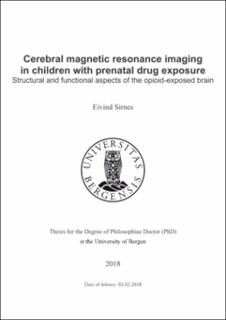| dc.contributor.author | Sirnes, Eivind | en_US |
| dc.date.accessioned | 2018-02-13T11:14:49Z | |
| dc.date.available | 2018-02-13T11:14:49Z | |
| dc.date.issued | 2018-02-02 | |
| dc.identifier.isbn | 978-82-308-38464 | en_US |
| dc.identifier.uri | https://hdl.handle.net/1956/17386 | |
| dc.description.abstract | Background: Over the last few decades brain imaging studies have made important contributions to our understanding of how prenatal drug exposure can impact normal brain development. The teratogenic potential of alcohol has been most widely studied, with growing evidence of structural and functional brain alterations in prenatally exposed children. However, the current knowledge on possible detrimental effects of drugs other than alcohol is still limited, and effects of prenatal opioids in particular, have only been explored in a few small-scale brain imaging studies. Aims: The overall aim was to investigate associations between prenatal drug exposure and later brain structure and function in children. The specific aims were to investigate gross anatomical brain changes after prenatal drug exposure and associations between prenatal opioids and morphometric and functional brain characteristics. Materials and methods: A hospital-based sample of 43 school-aged children with prenatal alcohol-, opioid- or polysubstance exposure and 43 sex- and age-matched unexposed controls underwent cerebral magnetic resonance imaging (MRI). All MRI scans were evaluated by an expert pediatric neuroradiologist blinded to the participants’ backgrounds. In children with confirmed exposure to opioids, volumetric brain characteristics were compared to controls. Brain activation patterns and performance on a working memory-selective attention task were compared between opioid-exposed and unexposed children using functional MRI (fMRI). Results: No association between prenatal drug exposure and gross structural brain changes was seen by means of expert visual analysis of cerebral MRI scans. Reduced regional brain volumes were found in prenatally opioid-exposed children compared to their matched controls. Functional imaging revealed impaired task performance and increased blood-oxygen-level-dependent (BOLD) activation in prefrontal cortical areas during the most cognitive demanding versions of the working memory-selective attention task in the opioid-exposed group as compared to unexposed controls. Conclusions: Cerebral MRI is probably of limited value in the clinical assessment of children with histories of prenatal drug exposure in a hospital setting, where polysubstance exposure and unspecified drug exposure is a common feature. Adverse effects of opioids on the developing fetal brain may explain the associations between prenatal opioids and brain alterations in children as seen by structural and functional MRI in this study. However, the sample was small and inevitably confounding factors were difficult to account for. Thus, further research is needed to explore the causal nature of these findings and to elucidate the functional consequences of the observed brain alterations in the opioid-exposed group. | en_US |
| dc.language.iso | eng | eng |
| dc.publisher | The University of Bergen | eng |
| dc.relation.haspart | Paper I: Cerebral Magnetic Resonance Imaging in Children With Prenatal Drug Exposure: Clinically Useful? Sirnes E, Elgen IB, Chong WK, Griffiths ST, Aukland SM Clinical Pediatrics. 2017 Apr; 56(4):326-332. Full text not available in BORA due to publisher restrictions. The article is available at: <a href="https://doi.org/10.1177/0009922816657154" target="blank">https://doi.org/10.1177/0009922816657154</a> | en_US |
| dc.relation.haspart | Paper II: Brain morphology in school-aged children with prenatal opioid exposure: A structural MRI study Sirnes E, Oltedal L, Bartsch H, Eide GE, Elgen IB, Aukland SM Early Human Development. 2017 Mar - Apr; 106-107:33-39. The article is available in the main thesis. The article is also available at: <a href="https://doi.org/10.1016/j.earlhumdev.2017.01.009" target="blank">https://doi.org/10.1016/j.earlhumdev.2017.01.009</a> | en_US |
| dc.relation.haspart | Paper III: Functional MRI in prenatally opioid-exposed children during a working memory-selective attention task. Sirnes E, Griffiths ST, Aukland SM, Eide GE, Elgen IB, Gundersen H. Neurotoxicology and Teratology. 2018 Mar-Apr; 66:46-54. The article is available in the main thesis. The article is also available at: <a href="https://doi.org/10.1016/j.ntt.2018.01.010" target="blank">https://doi.org/10.1016/j.ntt.2018.01.010</a> | en_US |
| dc.title | Cerebral magnetic resonance imaging in children with prenatal drug exposure. Structural and functional aspects of the opioid-exposed brain | en_US |
| dc.type | Doctoral thesis | |
| dc.rights.holder | Copyright the Author. All rights reserved | |
| dc.identifier.cristin | 1558349 | |
